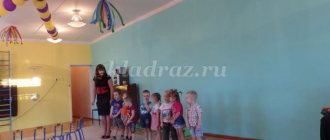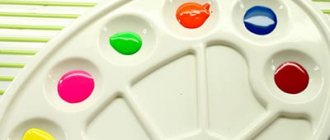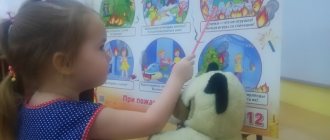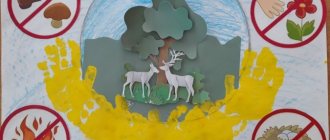September, October, November (1st period of study)
Lexical topics: “Toys”, “Vegetables”, “Autumn”, “Fruits”, “Our body”, “Face”.
Corrective tasks:
a) Formation of vocabulary and grammatical structure of speech:
• develop understanding of speech, the ability to listen attentively to the speech therapist’s speech;
• highlight the names of objects, actions, signs, understand the general meaning of words;
• to form an understanding and practical mastery of the plural form of nouns;
• form the assimilation of certain forms of inflection: endings of singular nouns in the accusative case, agreement of adjectives with masculine and feminine nouns, present tense verbs, endings of masculine and feminine past tense verbs.
b) Development of coherent speech:
• learn to master the skills of composing simple sentences (two words with demonstrative pronouns “this”, “here”, three words with a direct object expressed by a noun in the accusative case), based on questions, demonstrations of actions, based on a picture;
• teach the skills of writing a short descriptive story, retelling, telling a story using a picture using questions and a pre-compiled plan;
• develop dialogical speech skills.
c) Development of cognitive processes:
• ability to distinguish color (red, yellow, green), size (large, small), shape (circle, square, triangle);
• quantitative representations (one - many, two);
• to form visually effective, visually imaginative thinking, memory, attention;
• build awareness of your own body;
• form temporary ideas (autumn).
d) Formation of phonemic perception and sound pronunciation:
• introduce the articulatory apparatus;
• develop auditory attention;
• introduce the sounds “A”, “U”;
• form the prosodic side of speech;
• form the assimilation of the rhythmic structure of speech (memorization of poetry).
Summary of frontal speech therapy classes in the junior group of a preschool educational institution. Animals
Frontal speech therapy session with children of primary preschool age.
Topic “Animals” Author: Marina Alekseevna Durneva, teacher-speech therapist, MBDOU kindergarten No. 17, Kamensk-Shakhtinsky Description: This lesson was conducted with poorly speaking children of 3 years of age. When preparing the lesson, the emphasis was on the lexical topic “Animals”. This lesson will be useful for speech therapists and preschool teachers. Goal: Development of the lexical side of children’s speech (enrichment of children’s vocabulary on the topic “Animals”). Objectives: • develop fine, general and articulatory motor skills;
• cause onomatopoeia in children; • develop the ability to construct simple sentences and answer a question with a sentence; • develop speech hearing, ability to navigate in space and quantitative concepts; • cause the correct pronunciation of the sound [a], form the correct articulatory pattern; • enter the letter “A” as a symbol of the sound [a]; • develop attention, thinking, memory, perseverance, independence. Content
1. Greeting.
- Logori. — Finger game “Friendship” In our group, girls and boys are friends (the fingers of the hands are joined rhythmically in a lock)
You and I will make friends with small fingers
(rhythmic touching of the fingers of the same name on both hands)
One, two, three, four, five
(alternately touching the fingers of the same name, starting with the little fingers),
start counting again.
One two three four five. We've finished counting. (hands down, shake hands)
2. Main part.
— Introducing children into a play situation. Sovunya (a soft toy) arrives, meets the children, and tells the “Tale about the Tongue.” — Articulation gymnastics “Tongue walk.” The tongue woke up and smiled. “Smile”
Opened the window.
“Window”
Looked up, down,
“Swing”
One way, the other.
“Watch”
Closed the window.
Close your mouth
Went to brush your teeth.
I brushed my teeth upstairs and downstairs and went for a walk. “Brushing our teeth”
First, he took a swim in the river.
“Chatterbox”
Then he went to the mosquito to play ball.
“Z-z-z”
Then he helped the beetle wind the threads.
"AND…."
Then I went to the park to ride my horse.
"Horse"
Saw a plane.
I boarded the plane, started the engine, spread my wings and flew away. Hands to the sides, we fly in a circle: “L-l-l”
Landing.
We sat down
and wanted to go home by car.
I looked and the tires were flat. “Sh...”
Let's pump them up.
“Ssss”
Pumped up.
I got into the car and drove home. “I press the pedal and the car rushes into the distance: Dr-rr, dr-rr!” “Start the engine!”
— Game on onomatopoeia “Who talks like that?” 1. Sovunya offers children stencils of animals and individual pictures for them. She asks a riddle: “This beast shouts: “Moo-moo!” - This beast shouts: “Aw-aw!” - This animal screams: “Meow-meow!” - This beast shouts: “Be-be!” Children guess (we call the guess a sentence: “This is a cow (dog, cat, ram)”), find a suitable picture and look for its place in the stencil. After this, the onomatopoeia is repeated. 2. After this, the children’s pictures are collected again. The teacher names the animal, the children must name the onomatopoeia. Whoever says it first wins the card. 3. After playing out all the pictures, the children tell what pictures they have. - Who do you have? - I have a cow...... etc.
— A game for the development of speech hearing, spatial orientation and quantitative concepts “Bring a toy.” The teacher sits down at the table with the children and asks each one in turn to bring several toys (animal figures) from those laid out on another table: “Masha, bring the cat.” The child goes, completes the task and says what he did. - Dynamic pause - Logorhythmics. - Articulatory “imitation” for evoking sounds - Sound “A”. — Children are given a card cut into several parts. You need to put together a picture. What happened? - The teacher shows the whole picture: “I turn into a hippopotamus, I open my mouth very much: “Ah-ah.” Children pronounce the sound "A".
- The teacher shows the children pictures with different situations, and the children voice them (the cat and the baby are happy to meet - ah-ah; the cat burned its paw - ah-ah; the cat ran away with milk - ah-ah). — Finger game “Fingers say hello.” All fingers of the right hand, starting with the index, touch the thumb of the same hand in turn, while simultaneously pronouncing the sound “A” with each contact. — Introduction of the letter “A”. We can denote the sound “A” with the letter “A”. Children are given cards with a letter.
Let's trace the letter "A" with our finger and then with a felt-tip pen. - Logorhythmics - singing the sound “A”. This is a vowel letter and is very easy to sing. Let's sing it. — Letter recognition game “Find the letter.” Children are given different letters, they only need to find the letter “A”. After this, the music is turned on - the children dance; at the end of the music, everyone must take the letter “A” and show it. 3. Conclusion. The results are summed up, the children say goodbye.
We recommend watching:
Notes on speech therapy leisure for the junior group "Pets" Notes on the lesson "Poultry" junior speech therapy group Notes on a joint lesson for children and parents aged 3-4 years. Prevention of speech disorders in children Summary of individual speech therapy classes for children 3-4 years old
Similar articles:
Lesson notes on speech development in the second junior group
December, January, February (2nd period of study)
Lexical topics: “Clothes”, “Shoes”, “Winter”, “New Year”, “Winter fun”, “Winter clothes”, “Wild animals”.
Corrective tasks:
a) Formation of vocabulary and grammatical structure of speech:
• continue to form and consolidate previously studied grammatical categories;
• develop an understanding and practical use of singular forms of nouns in the genitive and accusative cases with prepositions and in the prepositional case;
• to form an understanding and practical mastery of the prepositions U, NA, V, IZ.
b) Development of coherent speech:
• continue to develop and strengthen the skills of writing sentences and simple descriptive stories;
• teach the skills of retelling stories and fairy tales “The Three Bears”, “Kolobok” using questions and a picture plan;
• continue to develop dialogical speech skills in the process of developing communication in preschoolers.
c) Development of cognitive processes:
• color (blue);
• continue the work started in the first period;
• form a serial series “big, smaller, small”, “small, bigger, big”;
• form temporary ideas (winter).
d) Formation of phonemic perception and sound pronunciation:
• continue the work started in the first period;
• introduce the sounds “I”, “O”, “E”;
• learn to perceive by ear and correctly reproduce the simple syllabic structure of words.
11.Big or small?
Goal: to teach children to correlate the words “big” and “small” with the size of objects. Materials: in this game you can compare any toys and objects; You can use pictures in further work. Progress of the game: When forming the concepts of “big” and “small”, it is useful to teach children to use expressive gestures: “big” - spread your arms to the sides (or simultaneously up and to the sides), “small” - bring your palms closer to each other (or bring your hands closer to each other). index and thumb towards each other). To do this, the speech therapist constantly uses these gestures and encourages children to use them. The names of concepts should be highlighted in speech. Show the children the big and small balls. Look, here's a ball, and here's a ball too. Are the balls the same? No, the balls are different. This ball is big! (the speech therapist shows the appropriate gesture), and this ball is small (the speech therapist shows the appropriate gesture). What kind of ball is this - show me. (the speech therapist encourages the children to show the gesture) That’s right, small. What is this ball? Show! (the speech therapist encourages the children to show a gesture) It is useful to repeat this game using a variety of subject material.
Articulation gymnastics
Articulation gymnastics is gymnastics for the tongue and lips. The tongue is the main muscle of the speech organs. The tongue must be trained and developed so that it can correctly perform certain specific movements, which are called sound pronunciation. Lips and tongue should be flexible and strong.
To perform articulation gymnastics you need a mirror. The child must see how his tongue works and where it is located. In order to bring the exercises to automaticity, you need to constantly practice. It is important to perform the exercises correctly and carefully monitor the position of the tongue.
You need to exercise every day for 5-7 minutes. Preferably 2 times a day. The result is correct and clear speech.
"Ball"
. Ask your baby to puff out his cheeks and deflate them. If he doesn't succeed right away, lightly press on them. Subsequently, you can inflate your cheeks one by one.
"Guess"
. Prepare hot and cold water, a teaspoon. When the child closes his eyes, touch the lips of the tongue with the device and ask him to guess what kind of water the spoon has been in.
"House"
. Opening his mouth (house), the baby shows his tongue, then hides it again.
"Gates"
. Opening your mouth wide, you need to secure the position (5 – 7 seconds).
"Smile"
. Smile and hold this position for the count.
"Delicious jam"
. Ask your baby to pretend to lick the jam from his lips. First from the top, then from the bottom.
Finger gymnastics for children 1-2 years old
- Cam
This finger is small (bend the little finger)
This finger is weak, (we bend the ring finger) This finger is long, (we bend the middle finger)
This finger is strong, (bend the index finger) This finger is fat, (bend the thumb)
Well, together - fist!
- On a visit
Visiting the thumb (the thumb is bent, the rest are clenched into a fist)
They came straight to the house:
Index and middle, (in accordance with the text, straighten your fingers alternately)
Nameless and last.
Little finger himself
He knocked on the threshold.
Together, fingers are friends, (clench your fingers into a fist and unclench them)
They cannot live without each other.
- Squirrel sitting on a cart
A squirrel sits on a cart, (clenching and unclenching her fingers into a fist in the rhythm of a nursery rhyme) She sells nuts: (we begin to bend our fingers) To the little fox-sister, to the sparrow, to the titmouse, to the fat-fifted bear, to the mustachioed hare, to whom in the goiter, to whom in the scarf, to whom in the sweetie .





